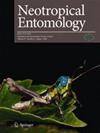Ariasa iporaensis n. sp. (Hemiptera: Cicadidae: Cicadinae: Fidicinini): An Uncommon Brazilian Dry Season Cicada.
IF 1.7
3区 农林科学
Q2 ENTOMOLOGY
引用次数: 0
Abstract
The cicada Ariasa iporaensis n. sp. is described. This new species of cicada stands out from others in the Brazilian Cerrado because the adults are present throughout the dry season. Notes on the acoustic behavior, oviposition, exuvia morphology, and emergence patterns are provided. An updated key to the species of Ariasa Distant, 1905 is also provided.
描述了蝉Ariasa iporaensis n. sp。这种新种蝉在巴西塞拉多的其他蝉中脱颖而出,因为成年蝉在整个旱季都存在。提供了关于声学行为、产卵、蜕皮形态和羽化模式的注释。此外,还提供了一份最新的Ariasa Distant, 1905种的密钥。
本文章由计算机程序翻译,如有差异,请以英文原文为准。
求助全文
约1分钟内获得全文
求助全文
来源期刊

Neotropical Entomology
生物-昆虫学
CiteScore
3.30
自引率
5.60%
发文量
69
审稿时长
6-12 weeks
期刊介绍:
Neotropical Entomology is a bimonthly journal, edited by the Sociedade Entomológica do Brasil (Entomological Society of Brazil) that publishes original articles produced by Brazilian and international experts in several subspecialties of entomology. These include bionomics, systematics, morphology, physiology, behavior, ecology, biological control, crop protection and acarology.
 求助内容:
求助内容: 应助结果提醒方式:
应助结果提醒方式:


